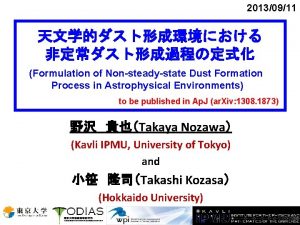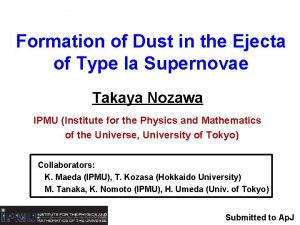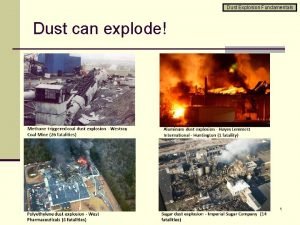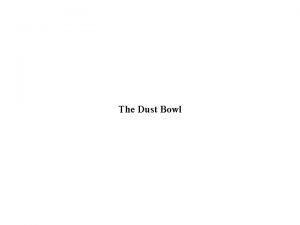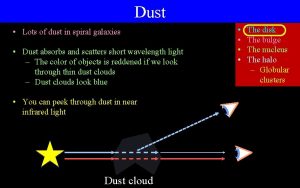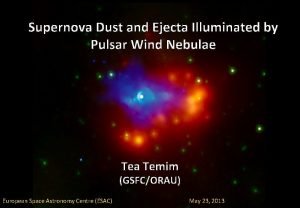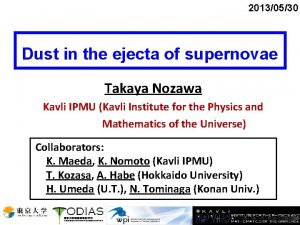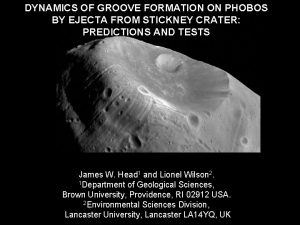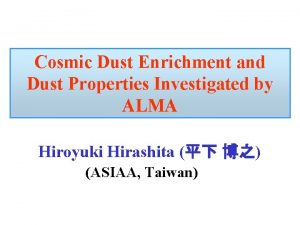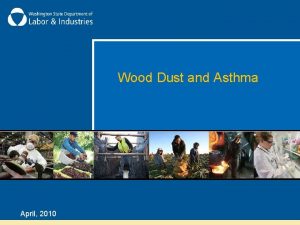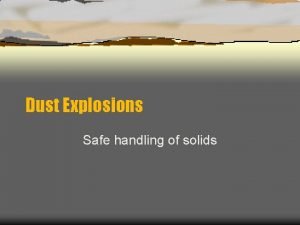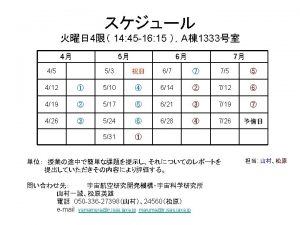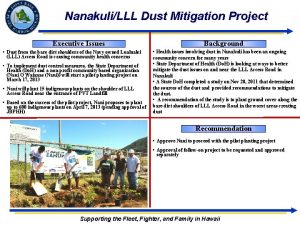20130806 Nonsteadystate dust formation in the ejecta of





















- Slides: 21

2013/08/06 Non-steady-state dust formation in the ejecta of Type Ia supernovae Takaya Nozawa (Kavli IPMU, University of Tokyo) Collaborators: Takashi Kozasa (Hokkaido University) Keiichi Maeda, Ken’ichi Nomoto (Kavli IPMU)

1 -1. Sources of dust in the early universe huge amounts of dust grains (>108 Msun) are detected SN 1987 A (< 1 Gyr) Casin A host galaxies of quasars at redshift z > 5 Crab ➔ Type II SNe arising from short-lived massive stars (> 8 Msun) must be main producers of dust ➔ 0. 1 Msun of dust per SN is needed (e. g. , Dwek+07) - theoretical works predict that 0. 1 -1. 0 Msun of dust can form in Type II SNe (e. g. , Nozawa+03; Nozawa+10) - FIR observations with Herschel discovered ~0. 1 Msun of cool dust in Cas A, SN 1987 A, and Crab (Barlow+10; Matsuura+11; Gomez+12 b) What are the main composition and typical size of newly formed dust in the ejecta of SNe?

1 -2. Dust formation in Type Ia SNe 〇 Type Ia supernovae (SNe Ia) - thermonuclear explosions of C+O white dwarfs with the mass close to Chandrasekhar limit (~1. 4 Msun) - synthesize a significant amount of heavy elements ➔ possible sources of interstellar dust? 〇 No evidence for dust formation in SNe Ia - no cool dust in Kepler and Tycho SNRs (Gomez+12 a) detection of warm dust of 10^-4 Msun in Tycho (Ishihara+10) What causes the difference in dust formation process? Kepler Tycho

1 -3. How do dust grains form? chemical approach gaseous atoms nucleation approach (e. g. Cherchneff+09) molecules formation of seed nuclei (steady-state nucleation rate) reaction rates unknown! clusters steady-state nucleation rate cannot be applied in rarefied astrophysical environments (e. g. , Donn & Nuth 1985) dust grains

2 -1. Concept of nucleation theory c 1 c(2) J 2 c(3) J 3 αn-1 c 1 cn-1 c(n) Jn β n cn ・ master equations

2 -2. Non-steady-state nucleation ・ steady-state nucleation rate: Js ➔ assuming Js = J 2 = J 3 = ・・・ = J∞ where μ = 4πa 02σ / k. T ・ non-steady-state dust formation n*= 100

2 -3. Basic equations for dust formation ・ Equation of mass conservation (cluster) (grain) ・ Equation of grain growth = c 10 x fcon ・ Evolutions of gas density and temperature (γ = 1. 1 -1. 7) Parameters: c 0, γ, t 0 (the time at which ln. S = 0) fiducial values: γ = 1. 25, t 0 = 300 day

3 -1. Steady vs. Non-steady (1) c 10 = 108 cm-3 C Mg. Si. O 3 ・ dashed line : non-steady model ・ dotted line : steady model The results for steady and non-steady models are essentially the same for high gas densities

3 -2. Steady vs. Non-steady (1): size distribution c 10 = 108 cm-3 C c 10 = 108 cm-3 Mg. Si. O 3 The steady-state nucleation rate is a good approximation for higher initial densities

3 -3. Steady vs. Non-steady (2) c 10 = 105 cm-3 C c 10 = 105 cm-3 Mg. Si. O 3 ・ I*: formation rate of grains with n* = 100 ・ Is : formation rate of grains with n = nc for τcoll/t 0 << 1 ➔ Is = … = In+1 = … = I* for τcoll/t 0 << 1 ➔ Is > … > In+1 > … > I*

3 -4. Steady vs. Non-steady (2): size distribution c 10 = 105 cm-3 C c 10 = 105 cm-3 Mg. Si. O 3 The combined size distribution of clusters and grains is in good agreement with the grain size distribution calculated with the steady-state nucleation rate

3 -5. Scaling relation of average grain radius C Mg. Si. O 3 Λon: ratio of supersaturation timescale to gas collision timescale at the onset time of dust formation Λon = τsat/τcoll ∝ τcool ngas where τcool = ton / 3 (γ – 1) Nozawa & Kozasa, submitted

3 -6. Scaling relation of average grain radius C Mg. Si. O 3 average radius condensation efficiency Nozawa & Kozasa, submitted

4 -1. Dust formation in Type Ia SN ○ Type Ia SN model W 7 model (C-deflagration) (Nomoto+84; Thielemann+86) - Meje = 1. 38 Msun - E 51 = 1. 3 - M(56 Ni) = 0. 6 Msun

4 -2. Results of dust formation calculations Λon = 30

4 -3. Mass of dust formed in Type Ia SNe in units of Msun Dust species Steady Non-steady C 8. 08 x 10 -3 3. 99 x 10 -3 Mg 2 Si. O 4 8. 79 x 10 -3 1. 21 x 10 -5 Mg. Si. O 3 2. 34 x 10 -2 3. 64 x 10 -6 Si. O 2 3. 40 x 10 -2 8. 39 x 10 -3 Al 2 O 3 1. 89 x 10 -3 0. 00 Fe. S 6. 06 x 10 -2 2. 83 x 10 -3 Si 1. 10 x 10 -1 9. 04 x 10 -2 Fe 4. 72 x 10 -2 4. 71 x 10 -2 Ni 1. 10 x 10 -2 1. 09 x 10 -2 0. 305 0. 164 Total

4 -4. Discussion on dust formation in SNe Ia 〇 Issues to be addressed - sticking probability: s = 1 in the calculations ➔ if s < 0. 1, any dust grain cannot condense - SN (W 7) model: massive carbon (Mc ~ 0. 05 Msun) ➔ observationally estimated carbon mass in SNe Ia : Mc < 0. 01 Msun (Marion+06; Tanaka+08) - M(56 Ni) ~ 0. 6 Msun in SNe Ia (cf. ~0. 06 Msun in SNe II) ➔ energetic photons and electrons resulting from 56 Ni decay destroy small clusters (e. g. , Nozawa+11)

5. Summary of this talk 〇 Steady-state nucleation rate is a good approximation if the gas density is high (τsat / τcoll >> 1) ➔ otherwise, non-steady effect becomes remarkable, leading to a lower fcon, ∞ and a larger aave, ∞ 〇 Steady-state nucleaition rate is applicable for Λon > 30 ➔ fcon, ∞ and aave, ∞ are determined by Λon = τsat / τcoll at the onset time (ton) of dust formation ➔ The approximation formulae for fcon, ∞ and aave, ∞ are given as a function of Λon 〇 Effect of non-steady state is remarkable in SNe Ia ➔ Masses of silicate/oxide grains are significantly reduced, compared to the results by steady model

5 -1. Dependence on t 0 c 10 = 107 cm-3 c 10 = 105 cm-3

5 -2. Dependence on gas cooling rate (γ) c 10 = 107 cm-3 c 10 = 105 cm-3

5 -3. Dependence on n* c 10 = 106 cm-3 c 10 = 105 cm-3 Mg. Si. O 3
 Formation initiale vs formation continue
Formation initiale vs formation continue Tỉ lệ cơ thể trẻ em
Tỉ lệ cơ thể trẻ em Thế nào là mạng điện lắp đặt kiểu nổi
Thế nào là mạng điện lắp đặt kiểu nổi Lời thề hippocrates
Lời thề hippocrates Vẽ hình chiếu đứng bằng cạnh của vật thể
Vẽ hình chiếu đứng bằng cạnh của vật thể Quá trình desamine hóa có thể tạo ra
Quá trình desamine hóa có thể tạo ra Các môn thể thao bắt đầu bằng tiếng nhảy
Các môn thể thao bắt đầu bằng tiếng nhảy Hình ảnh bộ gõ cơ thể búng tay
Hình ảnh bộ gõ cơ thể búng tay Khi nào hổ con có thể sống độc lập
Khi nào hổ con có thể sống độc lập điện thế nghỉ
điện thế nghỉ Dạng đột biến một nhiễm là
Dạng đột biến một nhiễm là Thế nào là sự mỏi cơ
Thế nào là sự mỏi cơ độ dài liên kết
độ dài liên kết Trời xanh đây là của chúng ta thể thơ
Trời xanh đây là của chúng ta thể thơ Voi kéo gỗ như thế nào
Voi kéo gỗ như thế nào Thiếu nhi thế giới liên hoan
Thiếu nhi thế giới liên hoan Vẽ hình chiếu vuông góc của vật thể sau
Vẽ hình chiếu vuông góc của vật thể sau Một số thể thơ truyền thống
Một số thể thơ truyền thống Thế nào là hệ số cao nhất
Thế nào là hệ số cao nhất Ng-html
Ng-html Hệ hô hấp
Hệ hô hấp Số nguyên tố là
Số nguyên tố là






















